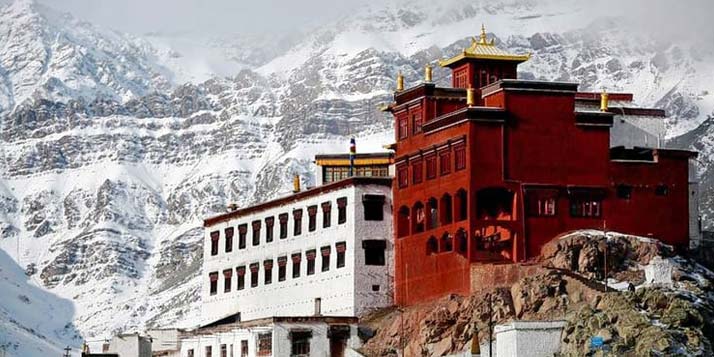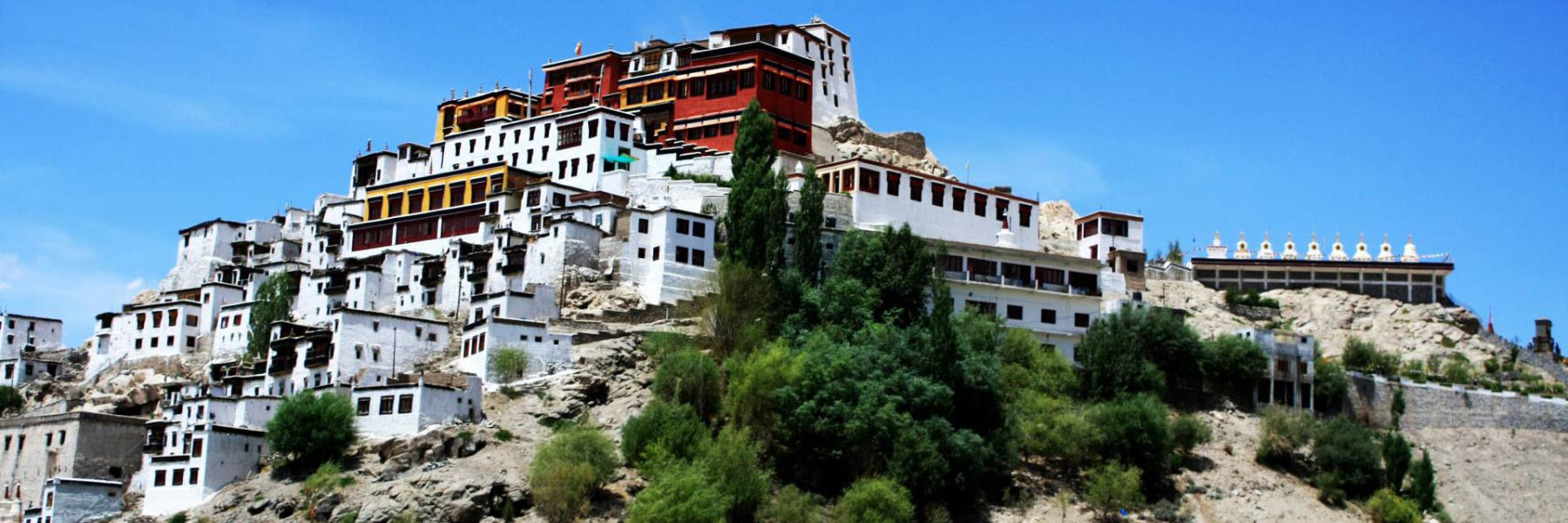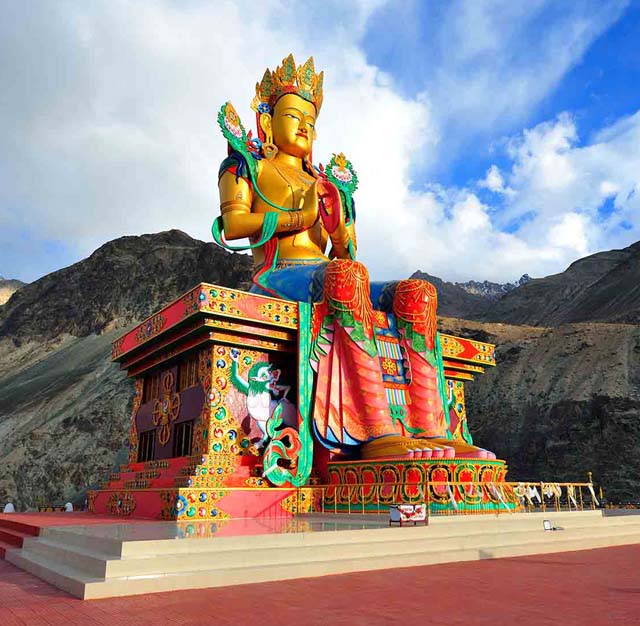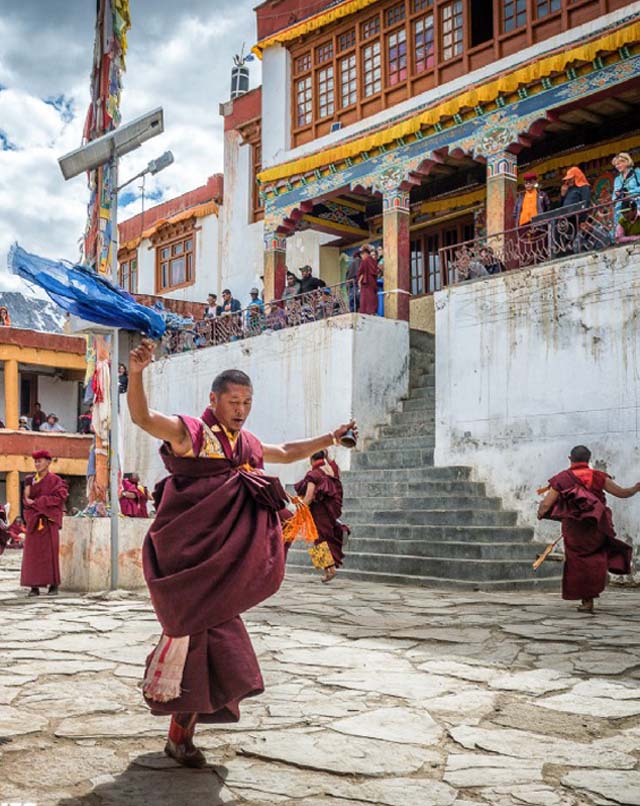The Magical Monasteries of Ladakh
May - Septemter Starting Point - Leh - Nubra Valley End Point - Sham Valley - LehThe Buddhist religion has a vital impact on tradition and cultures of Ladakh. Almost everyone in this beautiful place on earth is connected with a Buddhist group. And as a result, there are scores of monasteries all around. Most of these are world famous and apart from being culturally wise, they're an architectural delight too. In most of them, there are ancient Tibetan manuscripts, exquisitely carved wood work and icons of silver and gold. These monasteries are a rare site and must visit over Ladakh tour.

Tour Highlights
Explore the Leh city along with enchanting Shanti stupa.
Visit the “The Magical Monasteries of Ladakh “of Ladakh region.
Get the chance to explore the multi-hued Tibetan markets and historically rich Buddhist monasteries.
Witness some of the most sublime Himalayan sceneries throughout the picturesque tour.
Enjoy the beautiful Nubra valley (Sand Dune - Camel Safari), Sham Valley and wildlife exposure.
Get the opportunity to stay at remote mountain villages, interact with sweet and simple inhabitants.
Camp at scenic locations under the starry sky.

Think Ladakh and the first thought that will come to mind will be the Alchi, Lamayuru, Thiksey, Hemis and Diskit Monastery. These famous attractions of Ladakh contains many stupas, articles, lovely Thangkas and copper gilt Lord Buddha’s statue. Enveloped by lofty hills, the monasteries allure the tourists from all over the world with its architecture designs, peaceful environment, and the lovely Buddha statues. Along with all these, Likir Monastery, Chemrey Monastery, Phyang Gompa, Matho Monastery, Spituk Monastery, Sankar Monastery, Shey Monastery and more monastery should be included in Ladakh tour travel itinerary.
Ladakh Monastery Tour (Detailed Itinerary)
We not only plan your trip, but take care of every issue no matter big or small. Our motto is to create the most excellent destinations experience of your life. Simply give us a call and leave everything on our professionals.
Day 1: Arrival in Leh – Acclimatization Day – Shanti Stupa.
Upon arrival at Leh Airport you will meet by Global Himalayan Adventures representative and transfer to our pre-arranged hotel, rest of the day at leisure to acclimatize. Overnight stay at hotel. Evening, we visit Shanti Stupa or Japanese Stupa - A magnificent white-domed structure. The Japanese for World Peace built the Shanti Stupa, at Changspa, on the hilltop, and was inaugurated by His Holiness Dalai Lama in 1985. Its state of the art work attracts a lot of tourists to Ladakh and is spectacular to watch. From there one can see the nice spectacular view of Leh town. The stupa looks best at night, when it is beautifully illuminated with glittering lights. A large number of tourists come to Ladakh every year to visit this amazing stupa.
Day 2: Leh: Spituk – Sankar Monastery and Leh Palace.
After Breakfast, we will visit Spituk monastery, which was built in 15th century. Spituk lays some 6 kms south of Leh. Spituk or dpe-thub means ‘effective as an Example’ and this is thus a suitable name for the first Gelug-pa monastery in Ladakh. Inside the monastery, which includes several courtyards and temples of various sizes, has been built at different levels, following the shape of the rock.
Later in the afternoon, guided sightseeing tour visiting Sankar Gompa, located at a distance of approximately 3 km from the town of Leh. A subsidiary of the Spituk Gompa, it belongs to the Gelukpa or the Yellow Hat Sect. The monastery also serves as the official residence of the Ladakh’s head of Gelukpa Sect, known as The Kushok Bakula.
Leh Palace is one of the most captivating architectural ruins that attract the attention of the tourists almost immediately with its majestic setting at the edge of the Namgyal hill and overlooking the town and at once looks like a reminiscent of Lhasa’s Potala Palace. The Palace was built in the middle of the 16th century by King Singe Namgyal and still belongs to the royal family that now lives in the Stok Palace. The nine-storied monument is now in ruins. The palace remains locked and may be opened at request by a monk. Overnight stay at the hotel.
Day 3: Sham Valley: Phyang – Likir – Basgo and Alchi Monastery.
After breakfast we drive to Phyang, located 6 kms away from the Srinagar-Leh highway and 17 km from Leh. Phyang belongs to Dri-pung kagyu Order of Tibetan Buddhism. And we drive further to Likir. Likir gompa situated atop a windy cliff top overlooking the beautiful village of Likir, This Monastery is headed by the younger brother of Dalai Lama. According to tradition the foundation of Likir monastery goes back 11th century when it was a Bon centre. But the real foundation seems to be not earlier than 15th century. On the top on roof they have newly setup a museum which contains some very old Thankas brought from Tibet and the armoury, coins, seals etc.
Next we visit the 16th century Fort – Basgo. It is certainly the most impressive of Ladakhi citadels despite its ruined state. Amidst the ruins of the fort there are two large temples and adjoining one of there is a small shrine. Then we drive and cross the River Indus and reach Alchi, Ladakh’s most loved monastery. Over a century old, its wall paintings are very similar to those of the Tabo gompa in Spiti, Himachal Pradesh. Unlike other monasteries, which are usually on a cliff top or cling to a mountainside, Alchi is at ground level and is nestled in the shade of a garden. Overnight stay at Sham Valley.
Day 4: Sham Valley: Lamayuru and Ridzong Monastery, Back to Leh.
Lamayuru is around further towards Kargil. Lamayuru monastery belongs to Dripung Kagyu (Red Hat) like Phyang. The oldest structure in Lamayuru is the Singgey Lhakhang built by the founder of Alchi Lotsawa Rinchen Zangpo in 11th century. Lamayuru lower Ladakh its also called as sham.
After visit at Lamayuru Gonpa the drive to Ridzong Gompa: Rizong Gompa is known as the paradise for Meditation. Guru Padma Sambhava is believed to meditate here for years. One can still find the small caves where Lamas used to meditate for years cutting themselves from the rest of the world except for a one feet square outlet window from where they accept the one time meal of the day. Drive back to Leh and check in at hotel for overnight stay
Day 5: Leh: Matho – Stakna and Stok Palace.
Morning session we will visit 16th century’s Matho monastery. It is renowned mainly for its yearly festival, which takes place on the 14th and 15th of the first Tibetan month thus in late March or early April. It is known as Nag-hrang. Following drive to Stakna.
Stakna is a small monastery, comprising the private apartment, all newly decorated in good Tibetan style, a Du-khang and the rooms of monks and attendants. The Du-khang contains a silver gilt Stupa, some seven feet high, set up by the present Head Lama Stakna Rinpoche. After covering above two monasteries we drive back to Leh and visit Stok Palace on the way, Stok lies south of Leh on the opposite side of the Indus River. The castle was built on a hill at the end of village in about the year 1825 by King Tsespal Tondup Namgyal. In stok there is also the sacred monastery of Gurphug, a branch of Spituk Monastery. On the 9th and 10th days of the first Tibetan month of the festival called the “Guru Tshechu” is held during which the monks of Spituk Monastery come to perform the sacred dances. At that time two gods make their appearance.
Day 6: Hemis, Tak-thok and Chemdey Monastery.
We start with a visit to famous Hemis Gompa; this is the largest monastic foundation of Drukpa Kagyu Order of Tibetan Buddhism. Most of the other Drukpa monasteries are the branch monasteries of Hemis. It was built during early 17th century with the blessing of Lama Stagtsang Raspa (Shambunatha), by famous Namgyal dynasty king Singgey Namgyal.
The two-day festival of monastic dance in June-July (known as Hemis Festival) has raised the reputation of Hemis particularly high. The festival is dedicated to Guru Padmasambhava, popularly known as second Buddha and responsible for spreading Buddhism in the Tibetan world.
Tak-thok Monastery is situated in Sakti Village, at a distance of approximately 46 km from the town of Leh. The site where the monastery is now situated, once served as the meditation cave of Mahasidhas “Kunga Phuntsog”. The name Takthok literally means ‘rock-roof’. The monastery was so named, as both its roof as well as walls is made up of rock. Tak Thok belongs to the Nying-ma-pa sect of Buddhism, also known as the Old Order, and serves as the residence of approximately 55 lamas.
Chemday, The other monastery closely associated with Hemis is Chemday, which occupies an imposing position just to the south of Sakti village. The Du-khang contains images of stag-tshang Raspa, founder of the Hemis monastery and Chemday, and the last but one head-lama in this series of reincarnations. Behind the images are murals of Shakyamuni flanked by his two chief disciples and Bu Mandalas of Kalachakra of Akshobhya. After finishing the sightseeing tour we drive back to hotel for overnight stay.
Day 7: Leh: Shey Palace and Thiksey Monastery.
We start with a visit to Shey the ancient capital of Ladakh. The monastery here has a huge gold-gilded statue of Buddha Sakyamuni with a large silver lamp burning in front of the statue, built in the memory of King Singgey Namgyal by his son Deldan Namgyal in 1633 A.D. It is the only kind of statue made of Gold, Gilt and copper in entire Ladakh.
Then we visit Thiksey Gompa an impressive complex rising tier upon tier on a hill above the village. The monastery has a beautiful 30 m high gold-plated statue of Maitreya Buddha; the Buddha of the future is one of the most beautiful monasteries of Ladakh. Drive return to Leh. Overnight stay at the Hotel.
Day 8: Nubra Valley: Khardong La – Diskit Monastery – Camel Safari.
Leh to Nubra valley drive is 5 hours. We will cross Khardong Pass, which is the world highest motorable road at the altitude of 5630mts. Later you will visit the 14th century spectacular Diskit monastery and the giant statue of Maitreya Buddha. In the afternoon, explore your unique surroundings of high altitude sand dunes. There is the option of a taking a ride on a double humped camel. Overnight at the hotel (Hunder).
Day 9: Nubra Valley: Hot Spring Water, Sumoor and Ensa Monastery.
Drive out to Sumoor village driving past the Shayok River. Visit the 18th century Sumoor monastery. Later drive to Panamik village for the Hot Spring water Bath, which contain sulphur. Further we will visit the isolated enchanting Ensa monastery (600 year old) on the hilltop and can see the fabulous views over the Shyok valley and Karakoram ranges. Drive back to camp or hotel in the late afternoon.
Day 10: Nubra Valley to Leh.
After breakfast drive back to Leh on same route. Again you will cross the world highest motorable road – Khardong La. Enjoy the view from the other side of Nubra valley and Leh. Overnight stay at Hotel.
Day 11: Leh: Saboo Oracle (Optional) and Leisure day.
Early morning visit Saboo oracle for Prophecy Namgyal peak – Crowned by the now ruined fortress, houses Buddha’s deity Maitreya. It was here that the bodies of the defeated Mughals were offered to deities in the medieval era. Rest of the day at leisure to explore the beauty of Ladakh on your own and time for last day shopping.
Day 12: Departure from Leh.
Fly down to your hometown on this day in the former hours of the day. With all the memories in your heart, happily and blissfully.
The tour follows a stunning high valley with superb views across the mountain region and is one of the best ways to still experience the unique culture of the High Himalaya region.



Services included in the Tour/Trek:
What is not included in Tour/Trek:
Things To Carry:
When is the right time to travel to ladakh?
Unlike many destinations in India, Ladakh is not an all-year-around destination. Ladakh is a beautiful place that is located in the Himalayan range. It is located on the Indus River bank. This place has amazing scenery and many adventure routes for motorcycle enthusiasts. In short, the best time to visit Leh Ladakh is summer between the end of March to middle of August. The prime tourist time is between June and September.
Summer in Ladakh
The summer in Ladakh starts from April. The temperature can go as high as 30 degree C. During nights, the temperature would reach the minimum of 16 - 20 degree C. The summer here is neither cold nor hot. The climate would be pleasant all throughout the day. the summer ends in September. Summer ends in September. According to many, the best time to visit this place is between June and August. The summer would be at its prime and thus, the snow would all be melted giving the place a good greenery look. You can find a lot of tourists in this place during this period.
There is another reason for tourists to flock during this period. The Hermis Dance Festival is conducted during this time and it is a very vibrant and colourful event to watch. Starting from camping to trekking, you can enjoy a lot of adventure activities during this time. All passes, mountain routes, trekking routes and others would be open during this period. The lakes would be clear and it would be easy to camp near the river.
The top activities to enjoy during summer are Stok festival and Matho festival in March and May, Hemis festival and Phyang festival in June to August. Nubra Valley is a must visit for the summer tourists. Road trips to Manali and Sri Nagar would be at its prime beauty. In short, the best time to visit Leh Ladakh is summer between the end of March to middle of August. The prime tourist time is between June and August.
Monsoon in Ladakh
Rainfall starts in June and end by September. As you would have guessed this place would receive a lot of rainfall. The temperature would not be very cold, but the place would not be at its prime beauty. Most of the motorcycle and trekking routes would be blocked due to the rain. Many attractions would become inaccessible during this season. The temperature would be very pleasant and unless you want to drench in rain every day, it is better to avoid monsoon season. If you are planning to visit Ladakh during monsoon, make sure to watch Diskit and Thiksey festivals. You would be able to find considerable number of tourists during this season as the motorcycle tour passes would be at its prime beauty during this season. The trekking routes would be closed for safety purpose.
Winter in Ladakh
The winter starts from the second week of October and ends by February. The temperature can go as low as -20 degree C and as high as 2 degree C. The lakes would be frozen, motorcycle passes would be closed and trekking routes would be blocked. Almost all adventure activities becomes either dangerous or blocked. Still you can find a lot of tourists here during winter. Those who come to Ladakh for wildlife attraction would choose winter. This is when you can spot a lot of snow leopards here. Moreover, Spituk and Losar festivals happen in winter season. Last but not least, the place would be very beautiful like a fairy tale snow land. A lot of people consider winter as the best time to visit Ladakh due to the scenic beauty of the place.
How to reach Ladakh | Ladakh Journey Organiser
Ladakh is called the adventure capital of the country for a genuine reason. The geographical location of the place makes it an ultimate destination for anyone looking for an adrenaline filled vacation. Ladakh is one of the very few destinations in the world where the entertainment starts the moment you begin your travel towards it. Thanks to the scenic routes, the travel to Ladakh is as exciting as your vacation. The land is bestowed with mountains, valleys, snows, cold desert, frozen lakes, trekking routes, rivers, mountain passes and so on. If you have picked Ladakh as you next destination, you are in for an exciting vacation.
Srinagar to Leh (Primary Tactic)
Reach Ladakh from Kashmir Valley through Kargil, which is around 434 kms. This route remains open from early June to November. Zoji-La pass of the Himalayan ranges that is a gateway to Ladakh is approximately 11,500 feet (3,505 m high) above the sea level. J&K State Road Transport Corporation, J&K SRTC, runs regular deluxe and ordinary bus services between Srinagar and Leh. There's a night stay in Kargil. You can also hire cars, jeeps or taxis in Srinagar. If traveling in groups, you can rent deluxe buses for Leh, Kargil or Padum (Zanskar) from J&K SRTC at Srinagar.
Manali to Leh (Secondary Tactic)
Manali-Leh road of 473 kms, since 1989 has been another route to Ladakh. This route is open from mid-June to early October. The road passes through the desert plateau of Rupsho and is around 3,660m to 4,570m high. There are a number of high passes falling on the route,Taglang-La being second highest motorable road in the world, 17,469 feet (5,235m) above the sea level. Himachal Pradesh Tourism (HRTC) and J&K SRTC run daily deluxe and ordinary buses between Manali and Leh; that takes around hours (or two days) with night halt in camps at Sarchu or Pang. You can also hire a Gypsy or jeep taxis.
By Air (Third Tactic)
Leh - Kushok Bakula Rinpoche Airport is the main airport of the area. The flights are directly connected from Delhi, Srinagar and Jammu; by the flights run by Air India, Go Air and Jet Airways. The schedules are set already though, but these are subject to change according to the weather. It is advised that you keep your plans flexible.
Distances by Road
Other Domastic Tours
Amazing Short Tour
6 Days Ladakh Tour which takes you through some major attractions of Ladakh, the beautiful Hemis, Pangong Lake & Khardong pass.
Click for More Detail >>
Ladakh Short Tour
5 Days Short Tour which takes you through some major attractions like the beautiful Pangong Lake & Khardongla pass 5,380 Mtrs
Click for More Detail >>
Incredible Ladakh Tour
We have prepared the itinerary of 7 Days Leh Nubra, Lamayurur and Alchi Monastery Tour to experience the best of Ladakh.
Click for More Detail >>
Jeep Safari Tour
With the 10 Days Best of Ladakh Tour package, we give you the option to explore best of Ladakh. Experiences Jeep Safari in Ladakh.
Click for More Detail >>
Ladakh Lakes Tour
On this itinerary of Nubra valley, Pangong, Tsokar, Tsomoriri Lakes Tour of Ladakh, you also get to explore the monasteries of Ladakh.
Click for More Detail >>
Monastery Tour
Think Ladakh and the first thought that will come to mind will be the Alchi, Lamayuru, Thiksey, Hemis and Diskit Monastery.
Click for More Detail >>

Why Global Himalayan Adventures?
Established in the Year 2015 - Certified company.
Recognized by Tourism Department - UT Ladakh.
Certified Member of ALTOA (All Ladakh Tour Operators Association).
Led by a team who’re qualified with Basic Mountaineering Course and Advanced Mountaineering Course.
Organising fixed departure tours and treks across the Himalayas in Jammu & Kashmir, and other parts of North India.
1000+ Tours and Activities - We are always able to support you so that you have a hassle free experience.
Organising trekkings and expeditions at over 100 peaks across the Himalayas that are permitted by IMF (Indian Mountaineering Foundation).
Certified Member of ALTOA (All Ladakh Tour Operators Association).
Led by a team who’re qualified with Basic Mountaineering Course and Advanced Mountaineering Course.
Organising fixed departure tours and treks across the Himalayas in Jammu & Kashmir, and other parts of North India.
1000+ Tours and Activities - We are always able to support you so that you have a hassle free experience.
Organising trekkings and expeditions at over 100 peaks across the Himalayas that are permitted by IMF (Indian Mountaineering Foundation).
Organising fixed departure tours and treks across the Himalayas in Jammu & Kashmir, and other parts of North India.
1000+ Tours and Activities - We are always able to support you so that you have a hassle free experience.
Organising trekkings and expeditions at over 100 peaks across the Himalayas that are permitted by IMF (Indian Mountaineering Foundation).
Organising trekkings and expeditions at over 100 peaks across the Himalayas that are permitted by IMF (Indian Mountaineering Foundation).
Choose Your Holiday Destination in Ladakh
To help you find your way through getting a perfect experience of travelling in Ladakh, Global Himalayan Adventures has curate several travel packages covering some of the most popular holiday destinations in Ladakh.

Domestic Packages
In this section of Global Himalayan Adventures, you will find our pick of the best trending destinations for all types of families...
View Packages

Adventure Packages
Calling all adventure junkies! These treks originating from in and around Ladakh, are guaranteed to leave you inspired and breathless...
View Packages

Other Packages
Here we got some other holiday packages for you like Biking, Motorbike, Rafting on Indus and Zanskar Rivers and many more...
View Packages

Transportation Services
We provide Luxury, Standard and Comfort Category Cars, Tempo Traveller, Motorbikes and Mountaineering Bikes....
View Packages





